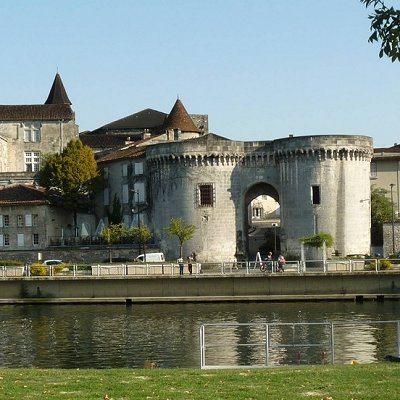
Like us on Facebook
PLACE NAMES


 
|
|
Cognac
|

| |
Cognac is situated on the river Charente between the towns of Angoulême and Saintes. The majority of the town has been built on the river's left bank, with the smaller right bank area known as the Saint Jacques district. The town is situated on one of the pilgrimage routes to Santiago de Compostela and home to the French Air Force training base 709. Cognac is 400 kilometres (250 mi) southwest of Paris.
Sights
- The Old Town. The town's medieval quarter "Vieux Cognac" runs from the Tours Saint-Jacques, alongside the river, up to the Saint-Léger church. The area contains many unusual buildings, built between the 15th and 18th centuries, situated on narrow cobbled streets. Many contain sculptures of the salamander, the symbol of King François I, as well as gargoyles and richly decorated façades.
- The Château des Valois, an important medieval trading post.
- The Saint-Léger church.
- The musée d'Art et d'Histoire (art and history museum)
- The musée des arts du Cognac (art museum)
- The Saint-Gobain glassworks and barrelworks
- Cognac Public Garden
The area also contains many Romanesque churches as well as several châteaux.
The town gives its name to one of the world's best-known types of brandy or eau de vie. Drinks must be made in certain areas around the town of Cognac and must be made according to strictly-defined regulations to be granted the name Cognac.
Cognac is a unique spirit in that it is double-distilled. This process can be viewed in one of the many "Grande Marque" Cognac houses which all have visitor centres. Most central in the town are Hennessy, Martell, Otard, Camus and Remy Martin. About 15 km (9.32 mi) East of Cognac is Jarnac, home to Courvoisier.
There are six vineyard areas around the Cognac area, all of which are within the Appellation Controlee for Cognac, but which are considered to vary in quality from the best growth area of "Grande Champagne" (nothing to do with the Champagne wine region in NE France), through "Petite Champagne" then "Borderies", "Fins Bois", "Bon Bois" and finally "Bois Ordinaire". The best Cognacs are generally only made using Grande and Petite Champagne grapes, but all Cognac is produced by blending a variety of "Eau de Vie" which can be made from grapes from different locations, and from different vintages. It is the Cellar master's skill that ensures that a brand's Cognac is recognisable regardless of when it is produced since he can blend multiple eaux de vie to achieve the right taste for his house.
Different qualities of Cognac are produced by all brands, and include VS ("Very Special"); VSOP ("Very Superior [or, more commonly, "Special", though the Bureau National Interprofessionnel du Cognac specifies "Superior"] Old Pale") and XO ("eXtra Old"). (English terms are still used, since in the early days of Cognac production it was the British and Irish who were the main consumers and also became some of the main producers of Cognac, using techniques acquired from the distillation of whisky, etc.) These are controlled by the length of time the Cognac is allowed to mature in oak barrels, a minimum time being required at each grade level. The longer the Cognac matures in the barrel the smoother it will generally become. Once it is bottled no further development takes place. Most houses still have barrels of Cognac dating back to the 19th century sitting in their cellars waiting for fine blending by the Cellar Master.
 Feel free to Email me any additions or corrections Feel free to Email me any additions or corrections
LINKS AVAILABLE TO YOUR SITE
| | |





